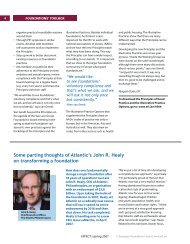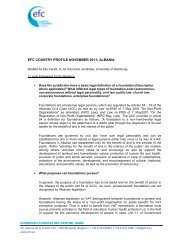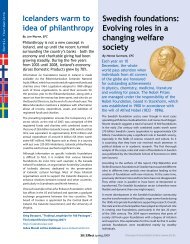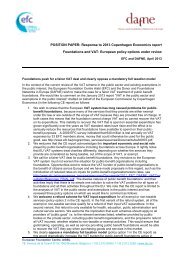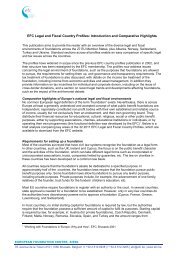European perspectives on global health: a policy glossary
European perspectives on global health: a policy glossary
European perspectives on global health: a policy glossary
You also want an ePaper? Increase the reach of your titles
YUMPU automatically turns print PDFs into web optimized ePapers that Google loves.
1. Europe must make <strong>global</strong> <strong>health</strong> a priority<br />
Global patterns of <strong>health</strong> and<br />
disease are shifting<br />
The <strong>global</strong> pattern of <strong>health</strong> refers to the<br />
distributi<strong>on</strong> of <strong>health</strong> and the determinants of<br />
<strong>health</strong> that affect the burden of diseases across<br />
different countries and regi<strong>on</strong>s of the world.<br />
During the past decade a great deal of effort has g<strong>on</strong>e<br />
into estimating with greater precisi<strong>on</strong> the extent of ill<strong>health</strong><br />
and its causes in different countries and regi<strong>on</strong>s<br />
of the world. Burden of disease estimates both describe<br />
the current situati<strong>on</strong> and provide a basis for comparis<strong>on</strong><br />
and describing trends. The most comm<strong>on</strong>ly used<br />
indicator is the disability-adjusted life year or DALY.<br />
Globally there has been a sustained decline in mortality<br />
in all parts of the world in the past century and<br />
especially the past three decades. However, there are<br />
important excepti<strong>on</strong>s ; there have been reversals in life<br />
expectancy in Sub-Saharan Africa in the past decade<br />
mainly as a result of increased mortality am<strong>on</strong>gst young<br />
adults and children due to HIV / AIDS. Health c<strong>on</strong>diti<strong>on</strong>s<br />
in Central and Eastern Europe have also deteriorated.<br />
In the past fifteen years inequalities in mortality<br />
between rich and poor countries and between socioec<strong>on</strong>omic<br />
groups within countries have rapidly<br />
widened. Accompanying this there have been changes<br />
in the pattern of disease in poor countries ( especially<br />
lower middle income countries ) with the rapid<br />
emergence of n<strong>on</strong>-communicable or lifestyle diseases<br />
in both poor and middle-income communities, with<br />
resulting increases in adult mortality and morbidity.<br />
In many lower middle-income countries a situati<strong>on</strong><br />
is rapidly emerging where infectious diseases persist<br />
together with high levels of n<strong>on</strong>-communicable<br />
diseases and high levels of violence and injury, often<br />
in the same community.<br />
The recent emergence of a ‘dual’ or ‘triple’ burden<br />
of disease in less developed countries can be traced<br />
to processes of <strong>global</strong>isati<strong>on</strong>. C<strong>on</strong>tinuing rural<br />
envir<strong>on</strong>mental degradati<strong>on</strong> and accompanying<br />
pauperisati<strong>on</strong> of rural communities are resulting in<br />
increasingly squalid living c<strong>on</strong>diti<strong>on</strong>s. Globalisati<strong>on</strong>,<br />
with accelerated movement of humans and animals<br />
( and animal products ) and more porous borders, is<br />
also leading to the rapid spread of both ‘old’ ( e. g.<br />
cholera, TB etc ) and new ( e.g. HIV, SARS, avian flu )<br />
infectious diseases. The increased penetrati<strong>on</strong>, as<br />
a result of ec<strong>on</strong>omic <strong>global</strong>isati<strong>on</strong> of ‘obesogenic’<br />
( processed, high fat, high sugar, high salt ) diets and<br />
increased sedentariness and the spread of <strong>global</strong><br />
‘bads’ ( e. g. tobacco, alcohol and habit-forming drugs )<br />
largely explain the rise of n<strong>on</strong>-communicable diseases,<br />
including mental illness, and c<strong>on</strong>tribute to increases in<br />
injuries, especially in poor communities.<br />
Europe has a resp<strong>on</strong>sibility for c<strong>on</strong>tributing to this<br />
burden not <strong>on</strong>ly as a legacy of col<strong>on</strong>ialism, but as<br />
the product of current policies. Trade and agriculture<br />
policies prevent rural communities in the developing<br />
world from earning their way out of poverty. Failure<br />
to counter the migrati<strong>on</strong> of <strong>health</strong> workers has led to<br />
the near collapse of <strong>health</strong> systems in many countries.<br />
Failures to provide access to <str<strong>on</strong>g>European</str<strong>on</strong>g> developments<br />
in pharmaceuticals and informati<strong>on</strong> technology or to<br />
match the Millennium Development Goals with aid<br />
and debt relief have made the problems worse.<br />
Many of the CEE states are experiencing a triple burden<br />
of poor <strong>health</strong> and early death, but there has been a<br />
lack of awareness of their <strong>health</strong> problems. The rates<br />
of n<strong>on</strong>-communicable diseases are increasing, due to<br />
poverty and lifestyle factors and result in much higher<br />
death rates due to the failure of <strong>health</strong> care services.<br />
These also c<strong>on</strong>tribute to high rates of maternal and<br />
infant mortality. Weak <strong>health</strong> protecti<strong>on</strong> services result<br />
in lower levels of immunisati<strong>on</strong>, increasing rates of<br />
infectious diseases such as HIV / AIDS, tuberculosis and<br />
syphilis. Basic c<strong>on</strong>diti<strong>on</strong>s for <strong>health</strong>, nutriti<strong>on</strong>, access to<br />
safe water, <strong>health</strong>y housing and social order are lacking<br />
for many people in CEE. Levels of deaths from c<strong>on</strong>flict<br />
and violence am<strong>on</strong>gst young men are three times<br />
higher in CEE countries than in the EU and alcohol<br />
abuse is a major cause of the decline in life expectancy<br />
in several of these countries.<br />
The EU is now starting to address the <strong>health</strong> and<br />
other social and ec<strong>on</strong>omic problems of countries in<br />
the wider regi<strong>on</strong> through its 2004 “Neighbourhood<br />
Policy”.<br />
In Europe as a whole :<br />
• N<strong>on</strong>-communicable diseases ( particularly<br />
cardiovascular diseases and mental illness such<br />
as depressi<strong>on</strong> ) represent 77 % of the burden of<br />
DALYs.<br />
16 <str<strong>on</strong>g>European</str<strong>on</strong>g> Foundati<strong>on</strong> Centre – <str<strong>on</strong>g>European</str<strong>on</strong>g> Partnership for Global Health



